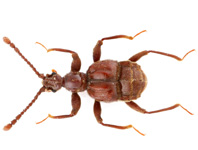Abstract
Eleven specimens of a previously undescribed species of Athesmia Looss, 1899 were recovered from six clapper rails, Rallus longirostris Boddaert (Rallidae), collected from November, 1984 through October, 1995 from the Galveston, Texas area of the Gulf of Mexico. Species of Athesmia can be divided into two body types based on the posterior extent of the ceca relative to the vitelline field (vitellarium): the attilae type where the ceca may be uneven, but they both extend at least to near the level of the posterior margin of the vitelline field, or more commonly surpass the vitelline field posteriorly and the heterolechithodes type where the cecum on the side of the vitelline field terminates well above the posterior margin of the vitelline field, usually near its anterior extremity, while the cecum opposite the vitelline field extends at least to the level of the posterior margin of the vitelline field, or more commonly surpasses the vitelline field posteriorly. Athesmia ralli n. sp. is assigned to the attilae type. The new species is most similar to Athesmia butensis Petri, 1942, but differs from this species by having a longer space from posterior testis to ovary (600–790 compared to less than 200), which represent a larger percentage of the total body length (7–8% compared to 2%) and a larger maximum egg size (47 by 29 compared to 42 by 25). The new species further differs from A. butensis by having a somewhat larger body, a longer forebody and the vitelline field reaches posteriorly to the posterior third of the body in the new species but is confined to the middle third of the body in A. butensis. A key to species also is provided.

